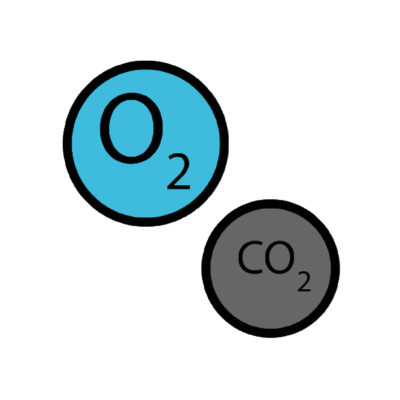Can we suffer from too much oxygen?
Better training and better recovery through breathing
Yes! More oxygen is always good, but the next question is: are we using the oxygen we take in? Oxygen fuels our bodies, fuels our muscles, fuels our workouts. And, during hard workouts, we’re all gasping for more air. Is it possible that we already have too much oxygen circulating in our bodies but we’re not accessing it effectively? Are there simple methods, during exercise and at rest, that help our bodies utilize oxygen more efficiently? Yes, and it all has to do with the way we breathe.
Tissue oxygen perfusion: oxygen and carbon dioxide exchange
First, a quick, simple anatomy and physiology review to help you visualize how to make breathing work better for you. When we breathe air into our lungs, it flows down the windpipe then splits into two branches called the bronchi. From here, there’s a vast network of smaller and smaller pathways where the air ends up at the smallest level in the alveoli sacs. This is where oxygen is absorbed by tiny capillaries and then transported through the body. At the cellular level, this process is called tissue perfusion. Gas exchange, of oxygen and carbon dioxide, only happens in the alveoli. Oxygen molecules then attach to hemoglobin inside the red blood cells to be carried to all tissues in your body: organs, working muscles, etc.
How much oxygen is in your blood? Oxygen saturation – SpO2
 This is how we understand how efficiently we’re able to utilize the oxygen we breathe in. Oxygen saturation measures the percentage of oxygen (carried by hemoglobin) in the blood and is a vital measurement of blood oxygen content and delivery. SpO2 measures the percentage of oxygen-carrying red blood cells present in the blood. Normal, healthy oxygen saturation levels are between 95-99%. And are easily measured with a simple, inexpensive tool called a fingertip pulse oximeter.
This is how we understand how efficiently we’re able to utilize the oxygen we breathe in. Oxygen saturation measures the percentage of oxygen (carried by hemoglobin) in the blood and is a vital measurement of blood oxygen content and delivery. SpO2 measures the percentage of oxygen-carrying red blood cells present in the blood. Normal, healthy oxygen saturation levels are between 95-99%. And are easily measured with a simple, inexpensive tool called a fingertip pulse oximeter.
For healthy athletes (that’s you!) who exercise regularly, your blood oxygen saturation is most likely in the normal range. But the reality is that taking in more oxygen with bigger deep breaths, although bringing in more oxygen, does not mean that this oxygen is getting to your working muscles and tissues. Much of the oxygen we take in is breathed out (25-75%!), unabsorbed, unused. It is possible to change this dynamic and improve how efficiently your body takes in and uses oxygen during rest and training. One of them is with regular aerobic exercise.
More CO2 is the answer to more available O2
Carbon dioxide, although seen as a metabolic “waste” product, is more important than oxygen. Yes, we need oxygen to fuel our workouts and to fuel our bodies, but more CO2 is the answer to more efficient utilization of oxygen in our bodies. Carbon dioxide sensitivity (levels) is the stimulus to breathe. Increased levels of carbon dioxide in your body stimulate your red blood cells to release more oxygen to your tissues, organs, and working muscles. Blood with more carbon dioxide in it becomes more acidic loosening the oxygen molecule from the red blood cell (the Bohr Effect). More carbon dioxide in the blood increases oxygenated blood flow to all cells.
In fact, for a healthy body, breathing in supplemental oxygen (think of a football player on the sidelines sucking in pure oxygen) is of little or no benefit. Blood oxygen may increase temporarily, but will never make it into our hungry muscle cells. We simply breathe it back out.
The best way to prevent many chronic health problems, improve athletic performance, and extend longevity is to focus on how we breathe, specifically to balance oxygen and carbon dioxide levels in the body.
In part 2, I’ll cover HOW to increase carbon dioxide levels and improve oxygen saturation.
References & Resources
The Bohr Effect
Mark Burhenne, Mark. The 8-Hour sleep paradox: How we are sleeping our way to fatigue, disease and unhappiness. askthedentist.com
Bussotti, Mauricio, et al. “Respiratory disorders in endurance athletes – how much do they really have to endure?”, Open Access Journal of Sports Medicine 2, no. 5 (April 2014):49.
Fingertip Pulse Oximeter
McKeown, Patrick. Oxygen Advantage. HarperCollins Publishers. 2015
Nasal breathing and exercise
Nestor, James. Breath. Penguin Random House. 2020
Nitric Oxide
More on oxygen saturation
